Ethical Dilemmas in Business: Three Case Studies Analysis Report
VerifiedAdded on 2021/05/25
|11
|3228
|130
Report
AI Summary
This report examines ethical dilemmas within the context of corporate governance, analyzing three distinct case studies to illustrate key challenges in business ethics. The first case focuses on worker rights, exploring the dilemma of a junior staff member facing work-life balance issues and workplace harassment. The second case delves into financial interest, specifically concerning audit planning and potential conflicts of interest within an accounting firm. The final case study addresses setting standards and code of conduct, using the example of a company director accused of misconduct and the subsequent stakeholder reactions. Each case includes a discussion of the ethical issues, potential courses of action, and the application of moral decision-making approaches, emphasizing the importance of transparency, ethical leadership, and adherence to corporate policies. The report highlights the need for businesses to balance profit maximization with stakeholder needs and to establish clear ethical guidelines to navigate complex situations.
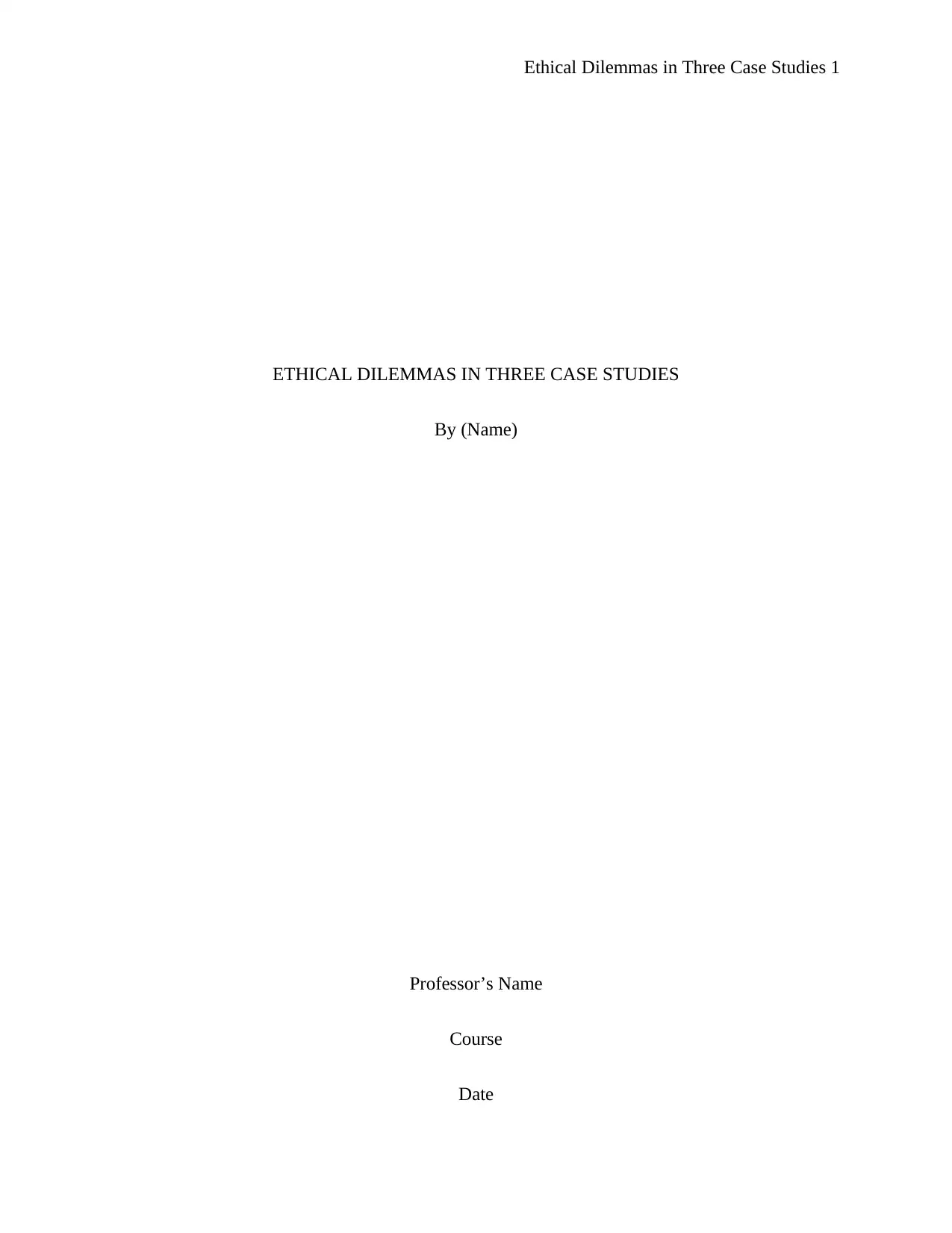
Ethical Dilemmas in Three Case Studies 1
ETHICAL DILEMMAS IN THREE CASE STUDIES
By (Name)
Professor’s Name
Course
Date
ETHICAL DILEMMAS IN THREE CASE STUDIES
By (Name)
Professor’s Name
Course
Date
Paraphrase This Document
Need a fresh take? Get an instant paraphrase of this document with our AI Paraphraser
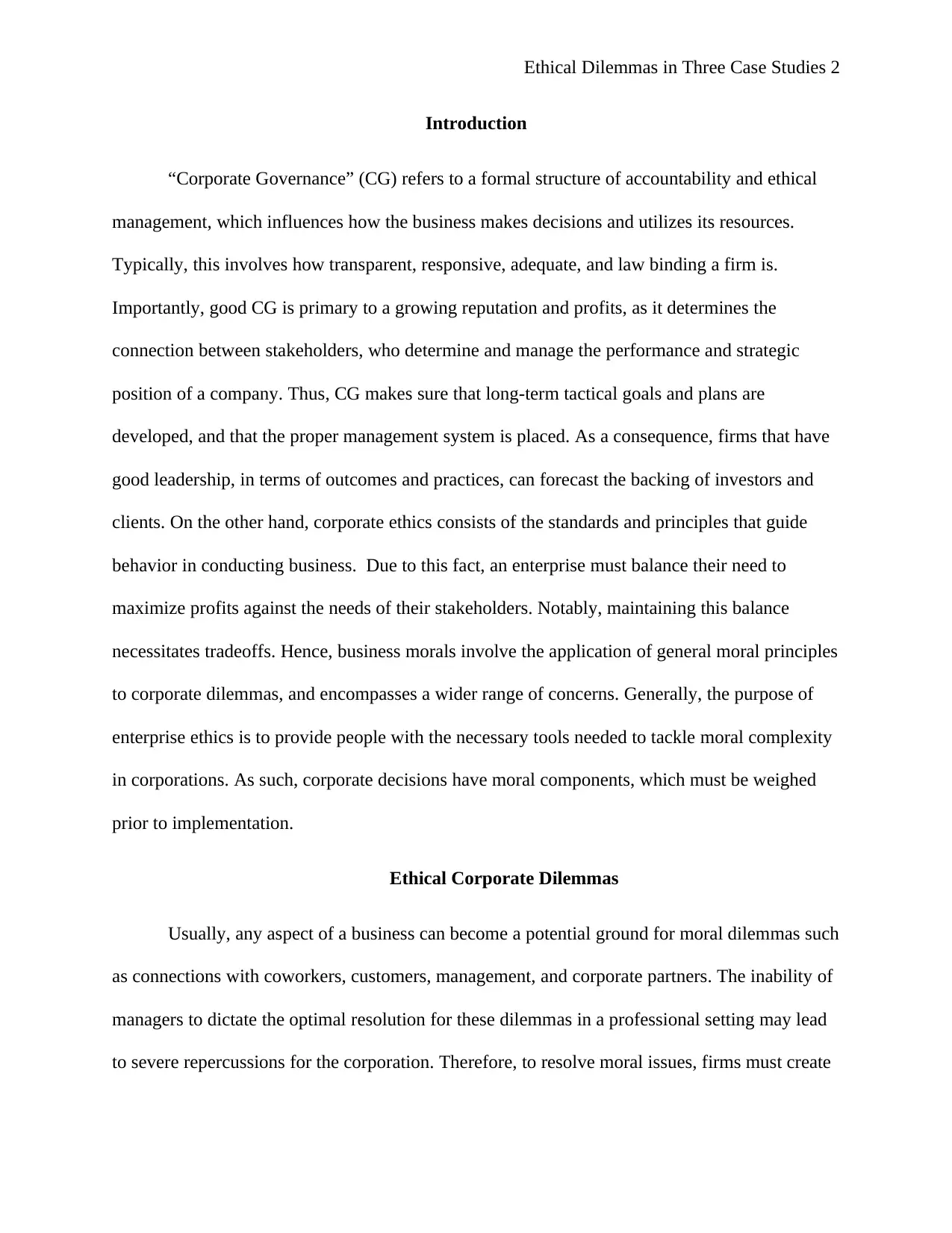
Ethical Dilemmas in Three Case Studies 2
Introduction
“Corporate Governance” (CG) refers to a formal structure of accountability and ethical
management, which influences how the business makes decisions and utilizes its resources.
Typically, this involves how transparent, responsive, adequate, and law binding a firm is.
Importantly, good CG is primary to a growing reputation and profits, as it determines the
connection between stakeholders, who determine and manage the performance and strategic
position of a company. Thus, CG makes sure that long-term tactical goals and plans are
developed, and that the proper management system is placed. As a consequence, firms that have
good leadership, in terms of outcomes and practices, can forecast the backing of investors and
clients. On the other hand, corporate ethics consists of the standards and principles that guide
behavior in conducting business. Due to this fact, an enterprise must balance their need to
maximize profits against the needs of their stakeholders. Notably, maintaining this balance
necessitates tradeoffs. Hence, business morals involve the application of general moral principles
to corporate dilemmas, and encompasses a wider range of concerns. Generally, the purpose of
enterprise ethics is to provide people with the necessary tools needed to tackle moral complexity
in corporations. As such, corporate decisions have moral components, which must be weighed
prior to implementation.
Ethical Corporate Dilemmas
Usually, any aspect of a business can become a potential ground for moral dilemmas such
as connections with coworkers, customers, management, and corporate partners. The inability of
managers to dictate the optimal resolution for these dilemmas in a professional setting may lead
to severe repercussions for the corporation. Therefore, to resolve moral issues, firms must create
Introduction
“Corporate Governance” (CG) refers to a formal structure of accountability and ethical
management, which influences how the business makes decisions and utilizes its resources.
Typically, this involves how transparent, responsive, adequate, and law binding a firm is.
Importantly, good CG is primary to a growing reputation and profits, as it determines the
connection between stakeholders, who determine and manage the performance and strategic
position of a company. Thus, CG makes sure that long-term tactical goals and plans are
developed, and that the proper management system is placed. As a consequence, firms that have
good leadership, in terms of outcomes and practices, can forecast the backing of investors and
clients. On the other hand, corporate ethics consists of the standards and principles that guide
behavior in conducting business. Due to this fact, an enterprise must balance their need to
maximize profits against the needs of their stakeholders. Notably, maintaining this balance
necessitates tradeoffs. Hence, business morals involve the application of general moral principles
to corporate dilemmas, and encompasses a wider range of concerns. Generally, the purpose of
enterprise ethics is to provide people with the necessary tools needed to tackle moral complexity
in corporations. As such, corporate decisions have moral components, which must be weighed
prior to implementation.
Ethical Corporate Dilemmas
Usually, any aspect of a business can become a potential ground for moral dilemmas such
as connections with coworkers, customers, management, and corporate partners. The inability of
managers to dictate the optimal resolution for these dilemmas in a professional setting may lead
to severe repercussions for the corporation. Therefore, to resolve moral issues, firms must create
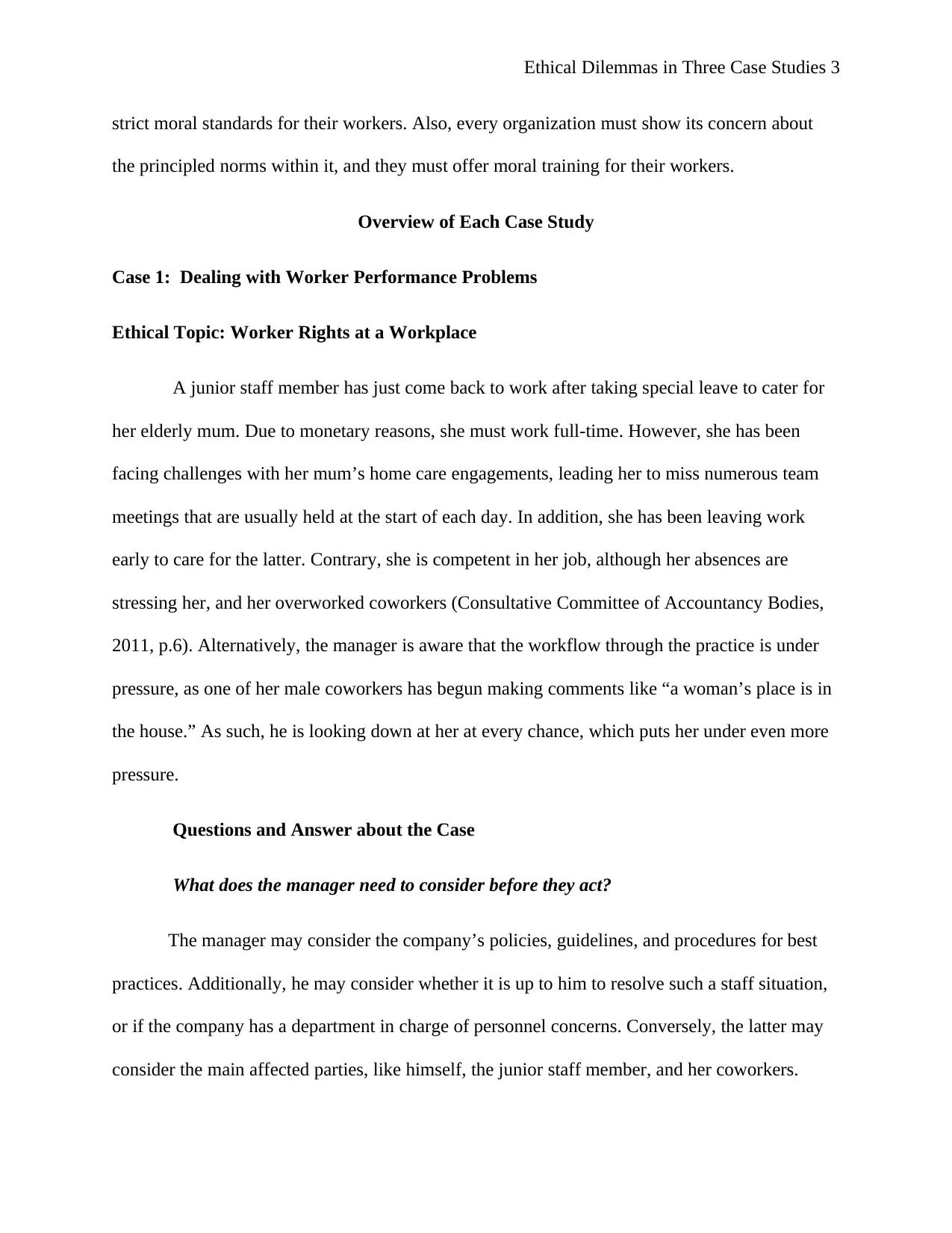
Ethical Dilemmas in Three Case Studies 3
strict moral standards for their workers. Also, every organization must show its concern about
the principled norms within it, and they must offer moral training for their workers.
Overview of Each Case Study
Case 1: Dealing with Worker Performance Problems
Ethical Topic: Worker Rights at a Workplace
A junior staff member has just come back to work after taking special leave to cater for
her elderly mum. Due to monetary reasons, she must work full-time. However, she has been
facing challenges with her mum’s home care engagements, leading her to miss numerous team
meetings that are usually held at the start of each day. In addition, she has been leaving work
early to care for the latter. Contrary, she is competent in her job, although her absences are
stressing her, and her overworked coworkers (Consultative Committee of Accountancy Bodies,
2011, p.6). Alternatively, the manager is aware that the workflow through the practice is under
pressure, as one of her male coworkers has begun making comments like “a woman’s place is in
the house.” As such, he is looking down at her at every chance, which puts her under even more
pressure.
Questions and Answer about the Case
What does the manager need to consider before they act?
The manager may consider the company’s policies, guidelines, and procedures for best
practices. Additionally, he may consider whether it is up to him to resolve such a staff situation,
or if the company has a department in charge of personnel concerns. Conversely, the latter may
consider the main affected parties, like himself, the junior staff member, and her coworkers.
strict moral standards for their workers. Also, every organization must show its concern about
the principled norms within it, and they must offer moral training for their workers.
Overview of Each Case Study
Case 1: Dealing with Worker Performance Problems
Ethical Topic: Worker Rights at a Workplace
A junior staff member has just come back to work after taking special leave to cater for
her elderly mum. Due to monetary reasons, she must work full-time. However, she has been
facing challenges with her mum’s home care engagements, leading her to miss numerous team
meetings that are usually held at the start of each day. In addition, she has been leaving work
early to care for the latter. Contrary, she is competent in her job, although her absences are
stressing her, and her overworked coworkers (Consultative Committee of Accountancy Bodies,
2011, p.6). Alternatively, the manager is aware that the workflow through the practice is under
pressure, as one of her male coworkers has begun making comments like “a woman’s place is in
the house.” As such, he is looking down at her at every chance, which puts her under even more
pressure.
Questions and Answer about the Case
What does the manager need to consider before they act?
The manager may consider the company’s policies, guidelines, and procedures for best
practices. Additionally, he may consider whether it is up to him to resolve such a staff situation,
or if the company has a department in charge of personnel concerns. Conversely, the latter may
consider the main affected parties, like himself, the junior staff member, and her coworkers.
⊘ This is a preview!⊘
Do you want full access?
Subscribe today to unlock all pages.

Trusted by 1+ million students worldwide
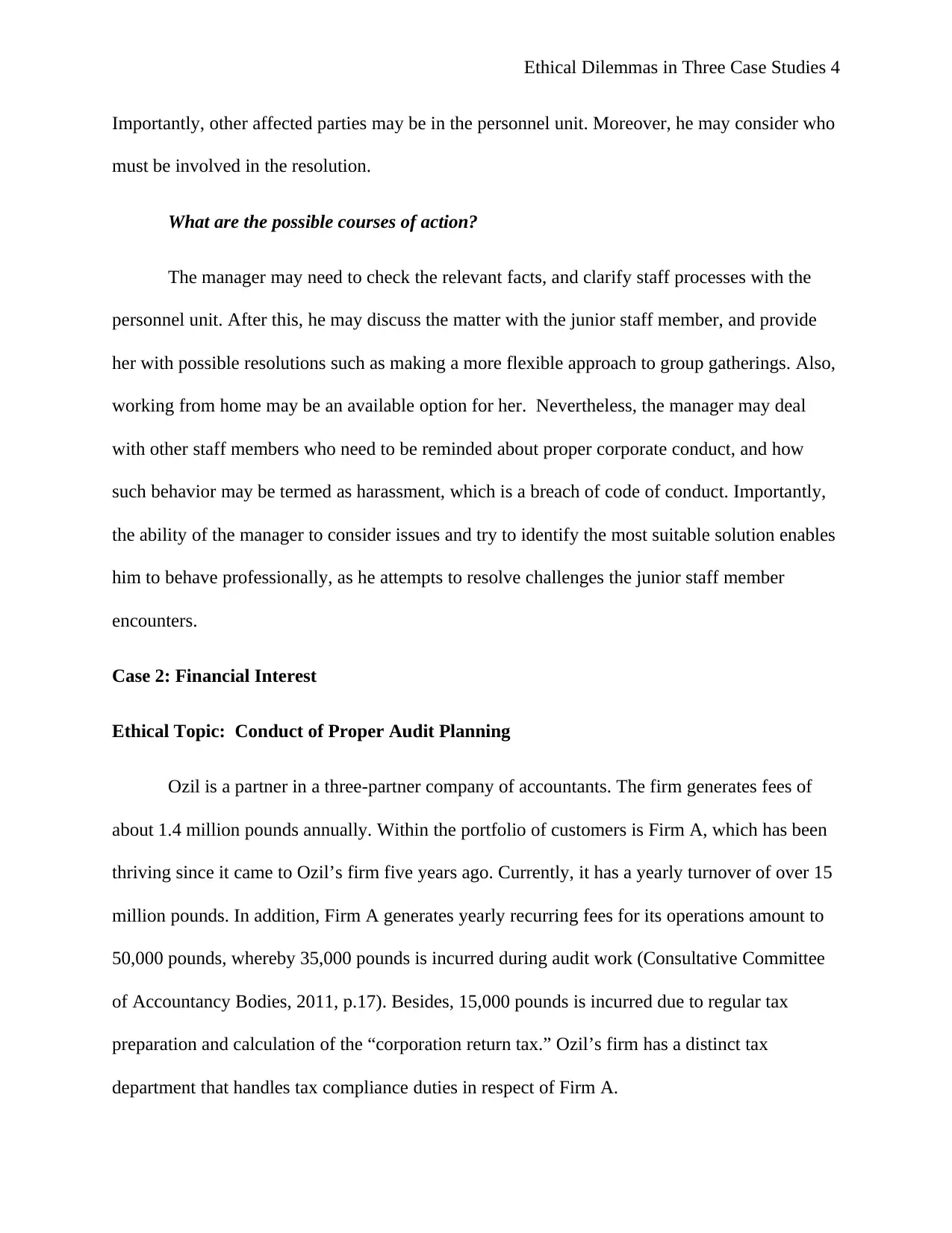
Ethical Dilemmas in Three Case Studies 4
Importantly, other affected parties may be in the personnel unit. Moreover, he may consider who
must be involved in the resolution.
What are the possible courses of action?
The manager may need to check the relevant facts, and clarify staff processes with the
personnel unit. After this, he may discuss the matter with the junior staff member, and provide
her with possible resolutions such as making a more flexible approach to group gatherings. Also,
working from home may be an available option for her. Nevertheless, the manager may deal
with other staff members who need to be reminded about proper corporate conduct, and how
such behavior may be termed as harassment, which is a breach of code of conduct. Importantly,
the ability of the manager to consider issues and try to identify the most suitable solution enables
him to behave professionally, as he attempts to resolve challenges the junior staff member
encounters.
Case 2: Financial Interest
Ethical Topic: Conduct of Proper Audit Planning
Ozil is a partner in a three-partner company of accountants. The firm generates fees of
about 1.4 million pounds annually. Within the portfolio of customers is Firm A, which has been
thriving since it came to Ozil’s firm five years ago. Currently, it has a yearly turnover of over 15
million pounds. In addition, Firm A generates yearly recurring fees for its operations amount to
50,000 pounds, whereby 35,000 pounds is incurred during audit work (Consultative Committee
of Accountancy Bodies, 2011, p.17). Besides, 15,000 pounds is incurred due to regular tax
preparation and calculation of the “corporation return tax.” Ozil’s firm has a distinct tax
department that handles tax compliance duties in respect of Firm A.
Importantly, other affected parties may be in the personnel unit. Moreover, he may consider who
must be involved in the resolution.
What are the possible courses of action?
The manager may need to check the relevant facts, and clarify staff processes with the
personnel unit. After this, he may discuss the matter with the junior staff member, and provide
her with possible resolutions such as making a more flexible approach to group gatherings. Also,
working from home may be an available option for her. Nevertheless, the manager may deal
with other staff members who need to be reminded about proper corporate conduct, and how
such behavior may be termed as harassment, which is a breach of code of conduct. Importantly,
the ability of the manager to consider issues and try to identify the most suitable solution enables
him to behave professionally, as he attempts to resolve challenges the junior staff member
encounters.
Case 2: Financial Interest
Ethical Topic: Conduct of Proper Audit Planning
Ozil is a partner in a three-partner company of accountants. The firm generates fees of
about 1.4 million pounds annually. Within the portfolio of customers is Firm A, which has been
thriving since it came to Ozil’s firm five years ago. Currently, it has a yearly turnover of over 15
million pounds. In addition, Firm A generates yearly recurring fees for its operations amount to
50,000 pounds, whereby 35,000 pounds is incurred during audit work (Consultative Committee
of Accountancy Bodies, 2011, p.17). Besides, 15,000 pounds is incurred due to regular tax
preparation and calculation of the “corporation return tax.” Ozil’s firm has a distinct tax
department that handles tax compliance duties in respect of Firm A.
Paraphrase This Document
Need a fresh take? Get an instant paraphrase of this document with our AI Paraphraser
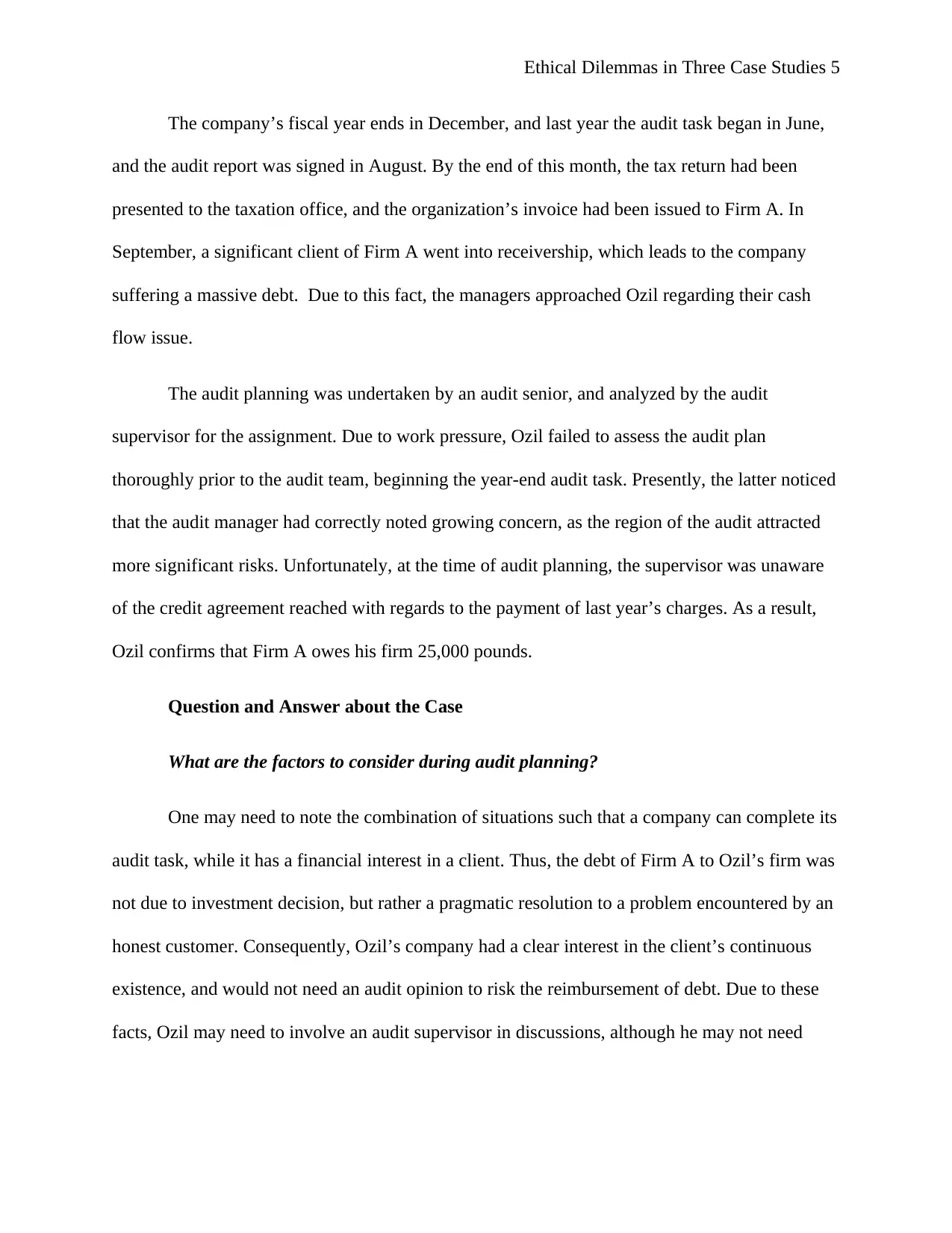
Ethical Dilemmas in Three Case Studies 5
The company’s fiscal year ends in December, and last year the audit task began in June,
and the audit report was signed in August. By the end of this month, the tax return had been
presented to the taxation office, and the organization’s invoice had been issued to Firm A. In
September, a significant client of Firm A went into receivership, which leads to the company
suffering a massive debt. Due to this fact, the managers approached Ozil regarding their cash
flow issue.
The audit planning was undertaken by an audit senior, and analyzed by the audit
supervisor for the assignment. Due to work pressure, Ozil failed to assess the audit plan
thoroughly prior to the audit team, beginning the year-end audit task. Presently, the latter noticed
that the audit manager had correctly noted growing concern, as the region of the audit attracted
more significant risks. Unfortunately, at the time of audit planning, the supervisor was unaware
of the credit agreement reached with regards to the payment of last year’s charges. As a result,
Ozil confirms that Firm A owes his firm 25,000 pounds.
Question and Answer about the Case
What are the factors to consider during audit planning?
One may need to note the combination of situations such that a company can complete its
audit task, while it has a financial interest in a client. Thus, the debt of Firm A to Ozil’s firm was
not due to investment decision, but rather a pragmatic resolution to a problem encountered by an
honest customer. Consequently, Ozil’s company had a clear interest in the client’s continuous
existence, and would not need an audit opinion to risk the reimbursement of debt. Due to these
facts, Ozil may need to involve an audit supervisor in discussions, although he may not need
The company’s fiscal year ends in December, and last year the audit task began in June,
and the audit report was signed in August. By the end of this month, the tax return had been
presented to the taxation office, and the organization’s invoice had been issued to Firm A. In
September, a significant client of Firm A went into receivership, which leads to the company
suffering a massive debt. Due to this fact, the managers approached Ozil regarding their cash
flow issue.
The audit planning was undertaken by an audit senior, and analyzed by the audit
supervisor for the assignment. Due to work pressure, Ozil failed to assess the audit plan
thoroughly prior to the audit team, beginning the year-end audit task. Presently, the latter noticed
that the audit manager had correctly noted growing concern, as the region of the audit attracted
more significant risks. Unfortunately, at the time of audit planning, the supervisor was unaware
of the credit agreement reached with regards to the payment of last year’s charges. As a result,
Ozil confirms that Firm A owes his firm 25,000 pounds.
Question and Answer about the Case
What are the factors to consider during audit planning?
One may need to note the combination of situations such that a company can complete its
audit task, while it has a financial interest in a client. Thus, the debt of Firm A to Ozil’s firm was
not due to investment decision, but rather a pragmatic resolution to a problem encountered by an
honest customer. Consequently, Ozil’s company had a clear interest in the client’s continuous
existence, and would not need an audit opinion to risk the reimbursement of debt. Due to these
facts, Ozil may need to involve an audit supervisor in discussions, although he may not need
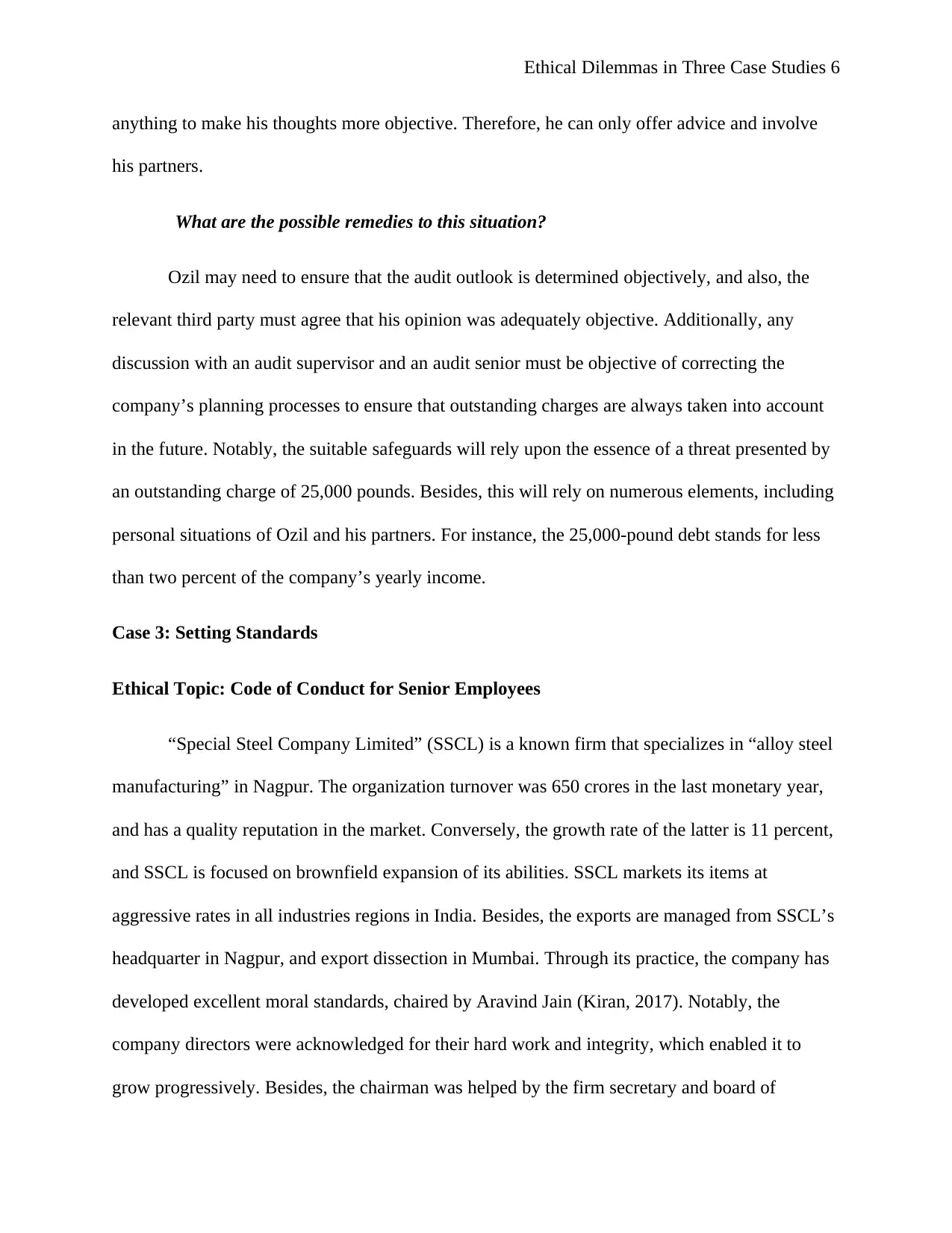
Ethical Dilemmas in Three Case Studies 6
anything to make his thoughts more objective. Therefore, he can only offer advice and involve
his partners.
What are the possible remedies to this situation?
Ozil may need to ensure that the audit outlook is determined objectively, and also, the
relevant third party must agree that his opinion was adequately objective. Additionally, any
discussion with an audit supervisor and an audit senior must be objective of correcting the
company’s planning processes to ensure that outstanding charges are always taken into account
in the future. Notably, the suitable safeguards will rely upon the essence of a threat presented by
an outstanding charge of 25,000 pounds. Besides, this will rely on numerous elements, including
personal situations of Ozil and his partners. For instance, the 25,000-pound debt stands for less
than two percent of the company’s yearly income.
Case 3: Setting Standards
Ethical Topic: Code of Conduct for Senior Employees
“Special Steel Company Limited” (SSCL) is a known firm that specializes in “alloy steel
manufacturing” in Nagpur. The organization turnover was 650 crores in the last monetary year,
and has a quality reputation in the market. Conversely, the growth rate of the latter is 11 percent,
and SSCL is focused on brownfield expansion of its abilities. SSCL markets its items at
aggressive rates in all industries regions in India. Besides, the exports are managed from SSCL’s
headquarter in Nagpur, and export dissection in Mumbai. Through its practice, the company has
developed excellent moral standards, chaired by Aravind Jain (Kiran, 2017). Notably, the
company directors were acknowledged for their hard work and integrity, which enabled it to
grow progressively. Besides, the chairman was helped by the firm secretary and board of
anything to make his thoughts more objective. Therefore, he can only offer advice and involve
his partners.
What are the possible remedies to this situation?
Ozil may need to ensure that the audit outlook is determined objectively, and also, the
relevant third party must agree that his opinion was adequately objective. Additionally, any
discussion with an audit supervisor and an audit senior must be objective of correcting the
company’s planning processes to ensure that outstanding charges are always taken into account
in the future. Notably, the suitable safeguards will rely upon the essence of a threat presented by
an outstanding charge of 25,000 pounds. Besides, this will rely on numerous elements, including
personal situations of Ozil and his partners. For instance, the 25,000-pound debt stands for less
than two percent of the company’s yearly income.
Case 3: Setting Standards
Ethical Topic: Code of Conduct for Senior Employees
“Special Steel Company Limited” (SSCL) is a known firm that specializes in “alloy steel
manufacturing” in Nagpur. The organization turnover was 650 crores in the last monetary year,
and has a quality reputation in the market. Conversely, the growth rate of the latter is 11 percent,
and SSCL is focused on brownfield expansion of its abilities. SSCL markets its items at
aggressive rates in all industries regions in India. Besides, the exports are managed from SSCL’s
headquarter in Nagpur, and export dissection in Mumbai. Through its practice, the company has
developed excellent moral standards, chaired by Aravind Jain (Kiran, 2017). Notably, the
company directors were acknowledged for their hard work and integrity, which enabled it to
grow progressively. Besides, the chairman was helped by the firm secretary and board of
⊘ This is a preview!⊘
Do you want full access?
Subscribe today to unlock all pages.

Trusted by 1+ million students worldwide
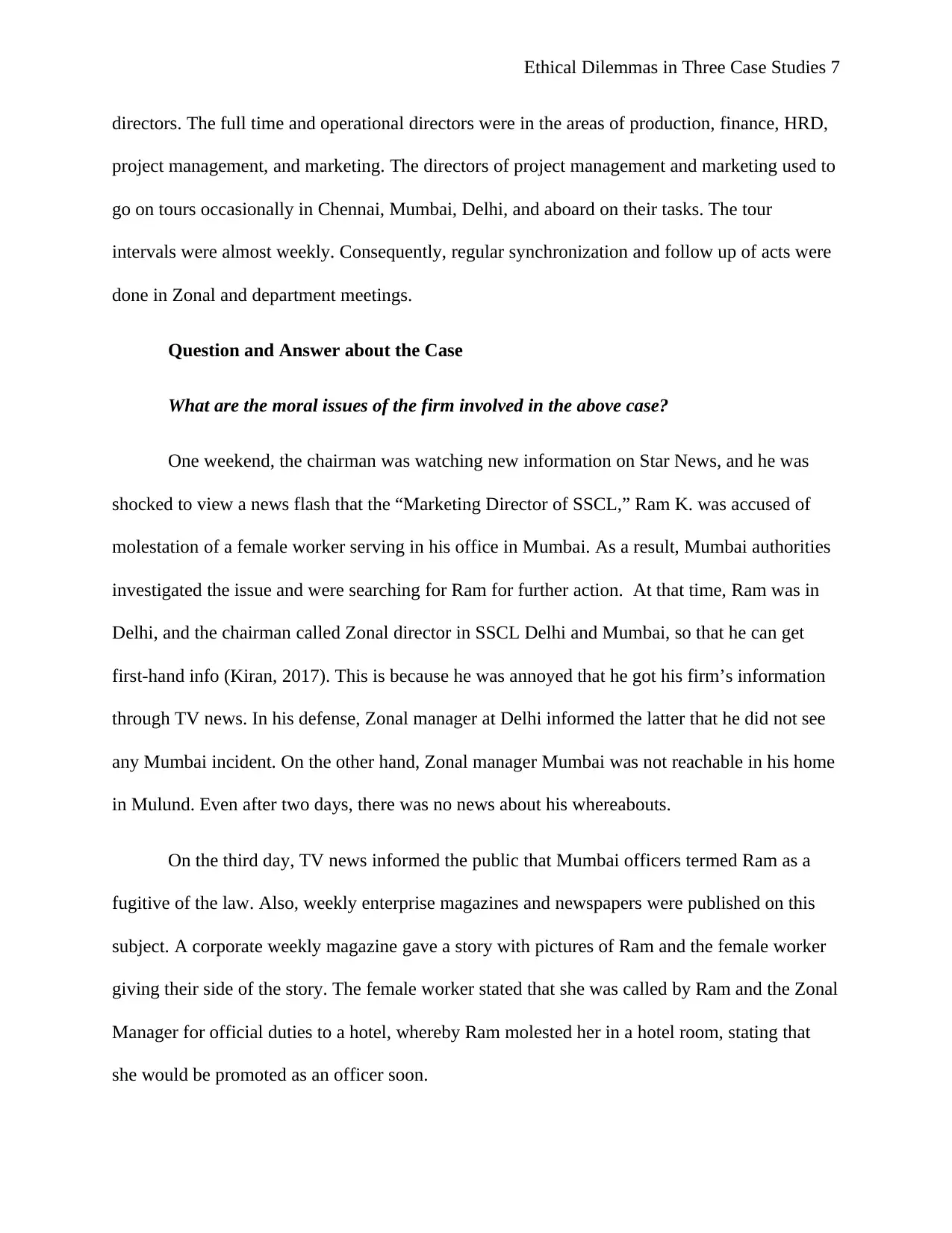
Ethical Dilemmas in Three Case Studies 7
directors. The full time and operational directors were in the areas of production, finance, HRD,
project management, and marketing. The directors of project management and marketing used to
go on tours occasionally in Chennai, Mumbai, Delhi, and aboard on their tasks. The tour
intervals were almost weekly. Consequently, regular synchronization and follow up of acts were
done in Zonal and department meetings.
Question and Answer about the Case
What are the moral issues of the firm involved in the above case?
One weekend, the chairman was watching new information on Star News, and he was
shocked to view a news flash that the “Marketing Director of SSCL,” Ram K. was accused of
molestation of a female worker serving in his office in Mumbai. As a result, Mumbai authorities
investigated the issue and were searching for Ram for further action. At that time, Ram was in
Delhi, and the chairman called Zonal director in SSCL Delhi and Mumbai, so that he can get
first-hand info (Kiran, 2017). This is because he was annoyed that he got his firm’s information
through TV news. In his defense, Zonal manager at Delhi informed the latter that he did not see
any Mumbai incident. On the other hand, Zonal manager Mumbai was not reachable in his home
in Mulund. Even after two days, there was no news about his whereabouts.
On the third day, TV news informed the public that Mumbai officers termed Ram as a
fugitive of the law. Also, weekly enterprise magazines and newspapers were published on this
subject. A corporate weekly magazine gave a story with pictures of Ram and the female worker
giving their side of the story. The female worker stated that she was called by Ram and the Zonal
Manager for official duties to a hotel, whereby Ram molested her in a hotel room, stating that
she would be promoted as an officer soon.
directors. The full time and operational directors were in the areas of production, finance, HRD,
project management, and marketing. The directors of project management and marketing used to
go on tours occasionally in Chennai, Mumbai, Delhi, and aboard on their tasks. The tour
intervals were almost weekly. Consequently, regular synchronization and follow up of acts were
done in Zonal and department meetings.
Question and Answer about the Case
What are the moral issues of the firm involved in the above case?
One weekend, the chairman was watching new information on Star News, and he was
shocked to view a news flash that the “Marketing Director of SSCL,” Ram K. was accused of
molestation of a female worker serving in his office in Mumbai. As a result, Mumbai authorities
investigated the issue and were searching for Ram for further action. At that time, Ram was in
Delhi, and the chairman called Zonal director in SSCL Delhi and Mumbai, so that he can get
first-hand info (Kiran, 2017). This is because he was annoyed that he got his firm’s information
through TV news. In his defense, Zonal manager at Delhi informed the latter that he did not see
any Mumbai incident. On the other hand, Zonal manager Mumbai was not reachable in his home
in Mulund. Even after two days, there was no news about his whereabouts.
On the third day, TV news informed the public that Mumbai officers termed Ram as a
fugitive of the law. Also, weekly enterprise magazines and newspapers were published on this
subject. A corporate weekly magazine gave a story with pictures of Ram and the female worker
giving their side of the story. The female worker stated that she was called by Ram and the Zonal
Manager for official duties to a hotel, whereby Ram molested her in a hotel room, stating that
she would be promoted as an officer soon.
Paraphrase This Document
Need a fresh take? Get an instant paraphrase of this document with our AI Paraphraser
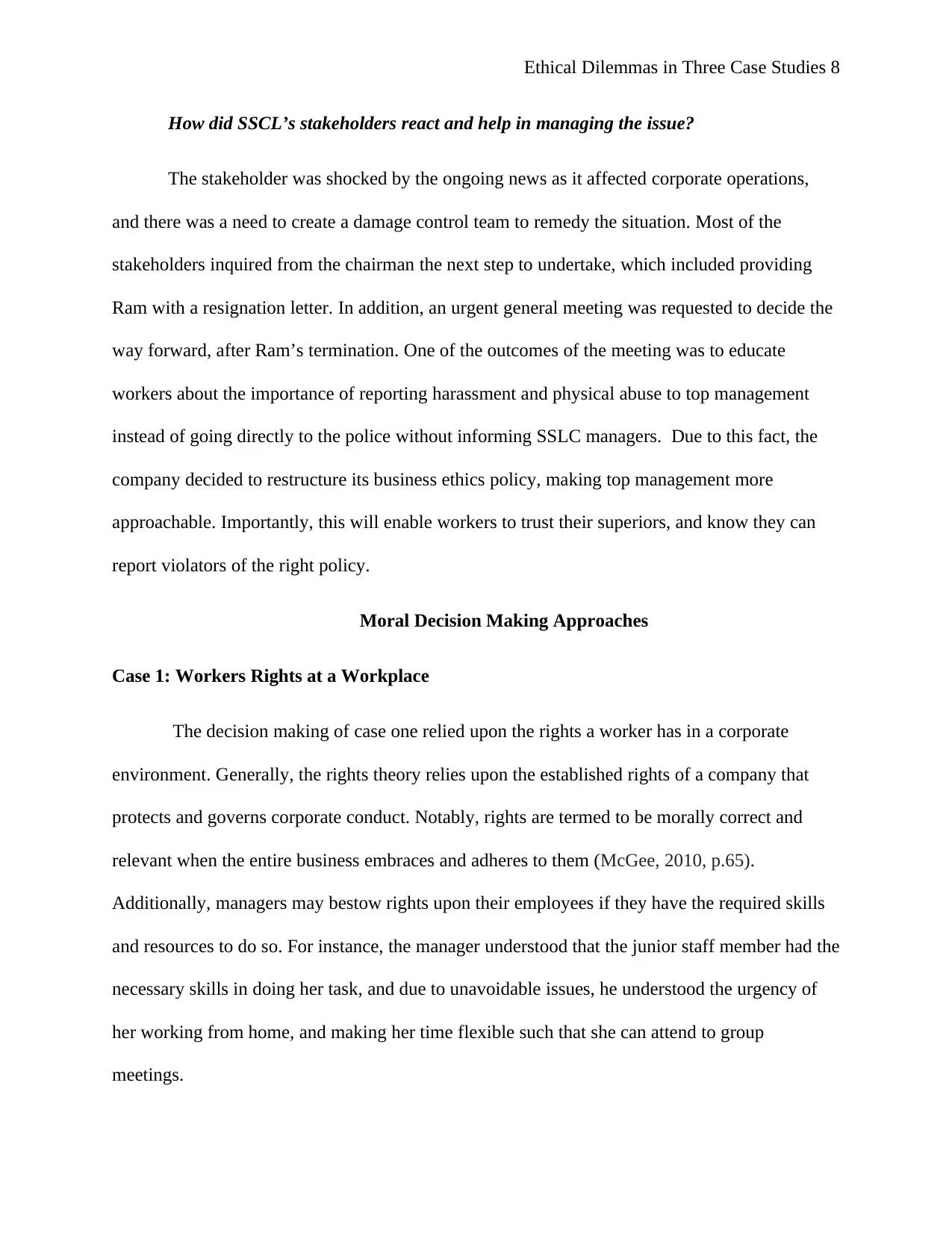
Ethical Dilemmas in Three Case Studies 8
How did SSCL’s stakeholders react and help in managing the issue?
The stakeholder was shocked by the ongoing news as it affected corporate operations,
and there was a need to create a damage control team to remedy the situation. Most of the
stakeholders inquired from the chairman the next step to undertake, which included providing
Ram with a resignation letter. In addition, an urgent general meeting was requested to decide the
way forward, after Ram’s termination. One of the outcomes of the meeting was to educate
workers about the importance of reporting harassment and physical abuse to top management
instead of going directly to the police without informing SSLC managers. Due to this fact, the
company decided to restructure its business ethics policy, making top management more
approachable. Importantly, this will enable workers to trust their superiors, and know they can
report violators of the right policy.
Moral Decision Making Approaches
Case 1: Workers Rights at a Workplace
The decision making of case one relied upon the rights a worker has in a corporate
environment. Generally, the rights theory relies upon the established rights of a company that
protects and governs corporate conduct. Notably, rights are termed to be morally correct and
relevant when the entire business embraces and adheres to them (McGee, 2010, p.65).
Additionally, managers may bestow rights upon their employees if they have the required skills
and resources to do so. For instance, the manager understood that the junior staff member had the
necessary skills in doing her task, and due to unavoidable issues, he understood the urgency of
her working from home, and making her time flexible such that she can attend to group
meetings.
How did SSCL’s stakeholders react and help in managing the issue?
The stakeholder was shocked by the ongoing news as it affected corporate operations,
and there was a need to create a damage control team to remedy the situation. Most of the
stakeholders inquired from the chairman the next step to undertake, which included providing
Ram with a resignation letter. In addition, an urgent general meeting was requested to decide the
way forward, after Ram’s termination. One of the outcomes of the meeting was to educate
workers about the importance of reporting harassment and physical abuse to top management
instead of going directly to the police without informing SSLC managers. Due to this fact, the
company decided to restructure its business ethics policy, making top management more
approachable. Importantly, this will enable workers to trust their superiors, and know they can
report violators of the right policy.
Moral Decision Making Approaches
Case 1: Workers Rights at a Workplace
The decision making of case one relied upon the rights a worker has in a corporate
environment. Generally, the rights theory relies upon the established rights of a company that
protects and governs corporate conduct. Notably, rights are termed to be morally correct and
relevant when the entire business embraces and adheres to them (McGee, 2010, p.65).
Additionally, managers may bestow rights upon their employees if they have the required skills
and resources to do so. For instance, the manager understood that the junior staff member had the
necessary skills in doing her task, and due to unavoidable issues, he understood the urgency of
her working from home, and making her time flexible such that she can attend to group
meetings.
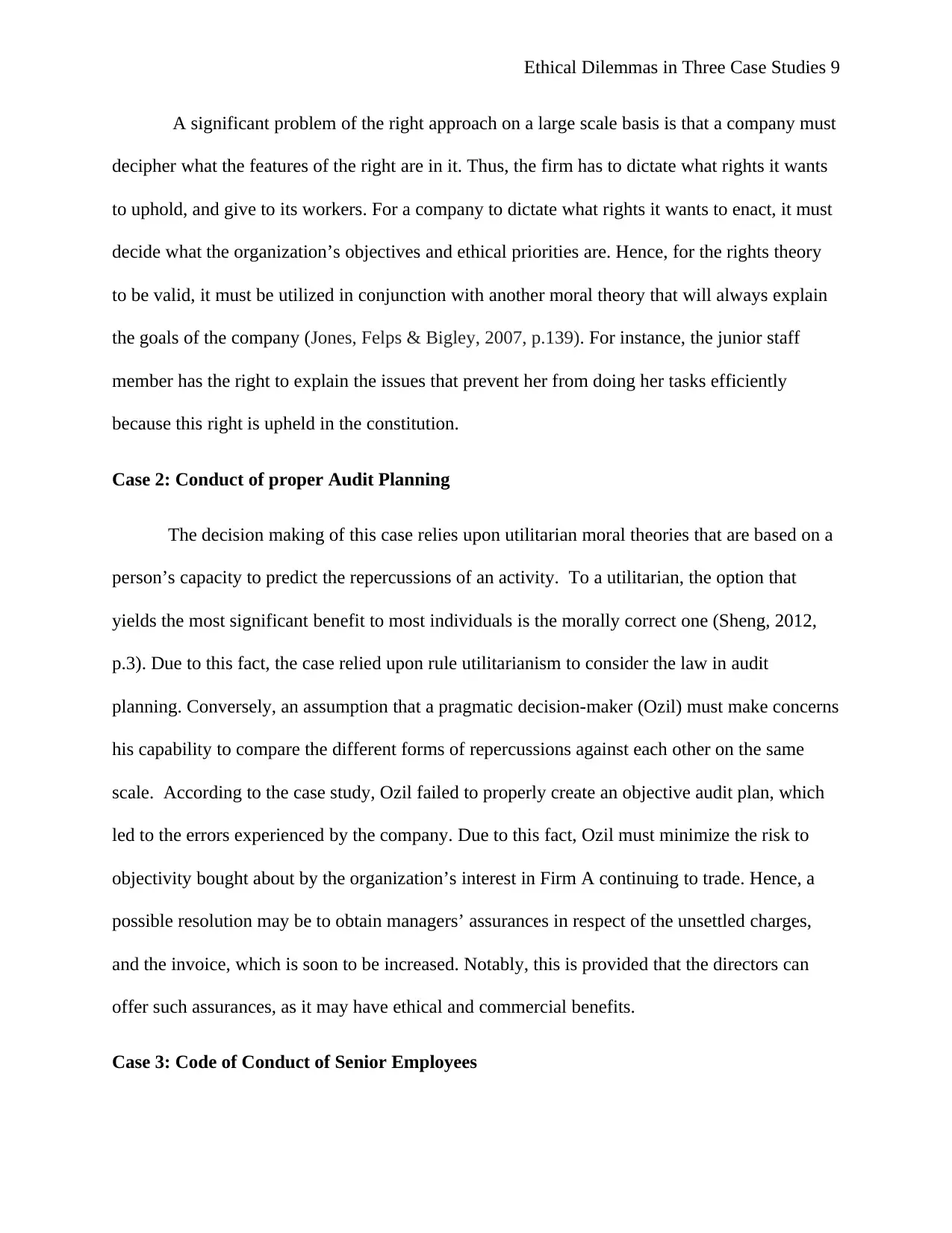
Ethical Dilemmas in Three Case Studies 9
A significant problem of the right approach on a large scale basis is that a company must
decipher what the features of the right are in it. Thus, the firm has to dictate what rights it wants
to uphold, and give to its workers. For a company to dictate what rights it wants to enact, it must
decide what the organization’s objectives and ethical priorities are. Hence, for the rights theory
to be valid, it must be utilized in conjunction with another moral theory that will always explain
the goals of the company (Jones, Felps & Bigley, 2007, p.139). For instance, the junior staff
member has the right to explain the issues that prevent her from doing her tasks efficiently
because this right is upheld in the constitution.
Case 2: Conduct of proper Audit Planning
The decision making of this case relies upon utilitarian moral theories that are based on a
person’s capacity to predict the repercussions of an activity. To a utilitarian, the option that
yields the most significant benefit to most individuals is the morally correct one (Sheng, 2012,
p.3). Due to this fact, the case relied upon rule utilitarianism to consider the law in audit
planning. Conversely, an assumption that a pragmatic decision-maker (Ozil) must make concerns
his capability to compare the different forms of repercussions against each other on the same
scale. According to the case study, Ozil failed to properly create an objective audit plan, which
led to the errors experienced by the company. Due to this fact, Ozil must minimize the risk to
objectivity bought about by the organization’s interest in Firm A continuing to trade. Hence, a
possible resolution may be to obtain managers’ assurances in respect of the unsettled charges,
and the invoice, which is soon to be increased. Notably, this is provided that the directors can
offer such assurances, as it may have ethical and commercial benefits.
Case 3: Code of Conduct of Senior Employees
A significant problem of the right approach on a large scale basis is that a company must
decipher what the features of the right are in it. Thus, the firm has to dictate what rights it wants
to uphold, and give to its workers. For a company to dictate what rights it wants to enact, it must
decide what the organization’s objectives and ethical priorities are. Hence, for the rights theory
to be valid, it must be utilized in conjunction with another moral theory that will always explain
the goals of the company (Jones, Felps & Bigley, 2007, p.139). For instance, the junior staff
member has the right to explain the issues that prevent her from doing her tasks efficiently
because this right is upheld in the constitution.
Case 2: Conduct of proper Audit Planning
The decision making of this case relies upon utilitarian moral theories that are based on a
person’s capacity to predict the repercussions of an activity. To a utilitarian, the option that
yields the most significant benefit to most individuals is the morally correct one (Sheng, 2012,
p.3). Due to this fact, the case relied upon rule utilitarianism to consider the law in audit
planning. Conversely, an assumption that a pragmatic decision-maker (Ozil) must make concerns
his capability to compare the different forms of repercussions against each other on the same
scale. According to the case study, Ozil failed to properly create an objective audit plan, which
led to the errors experienced by the company. Due to this fact, Ozil must minimize the risk to
objectivity bought about by the organization’s interest in Firm A continuing to trade. Hence, a
possible resolution may be to obtain managers’ assurances in respect of the unsettled charges,
and the invoice, which is soon to be increased. Notably, this is provided that the directors can
offer such assurances, as it may have ethical and commercial benefits.
Case 3: Code of Conduct of Senior Employees
⊘ This is a preview!⊘
Do you want full access?
Subscribe today to unlock all pages.

Trusted by 1+ million students worldwide
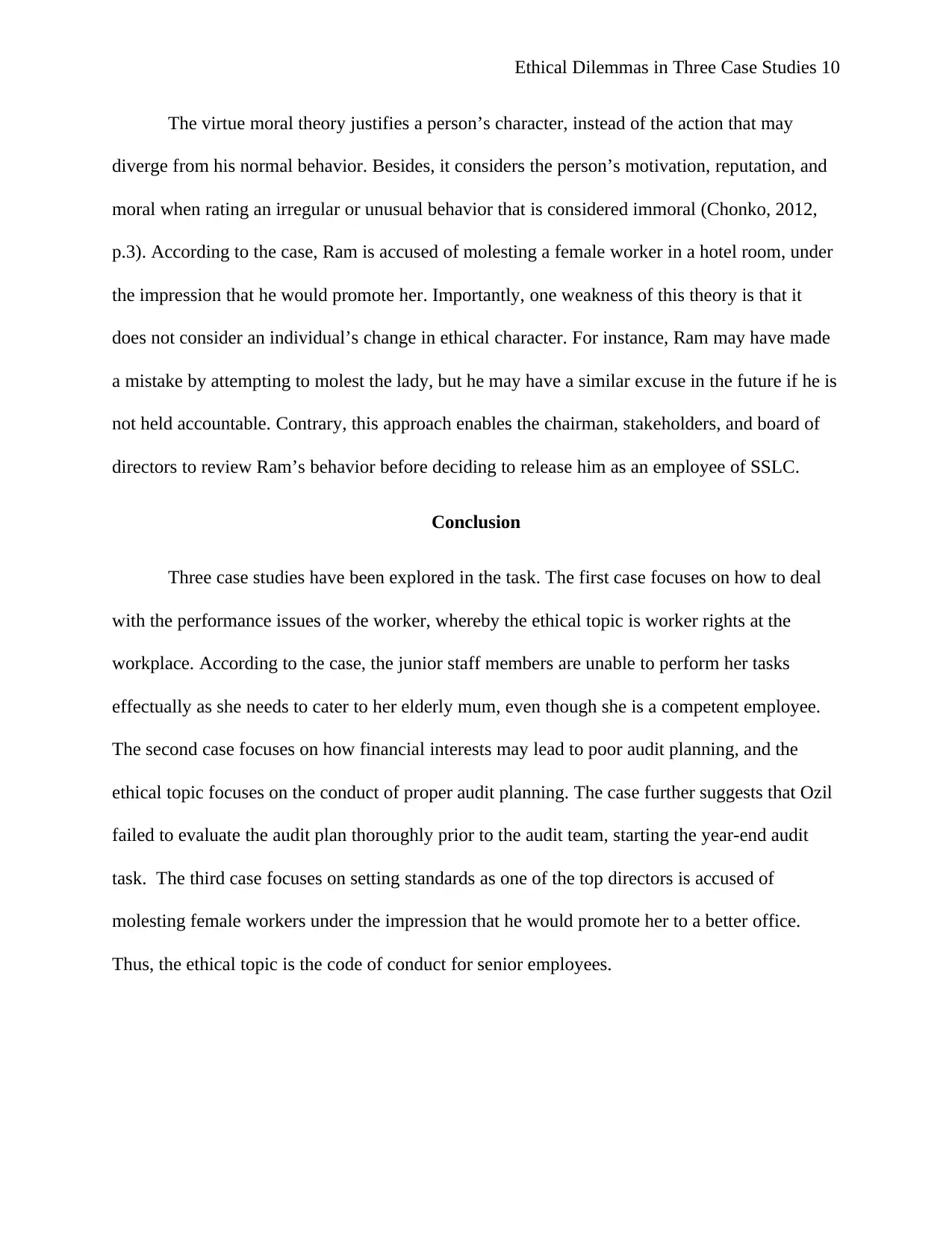
Ethical Dilemmas in Three Case Studies 10
The virtue moral theory justifies a person’s character, instead of the action that may
diverge from his normal behavior. Besides, it considers the person’s motivation, reputation, and
moral when rating an irregular or unusual behavior that is considered immoral (Chonko, 2012,
p.3). According to the case, Ram is accused of molesting a female worker in a hotel room, under
the impression that he would promote her. Importantly, one weakness of this theory is that it
does not consider an individual’s change in ethical character. For instance, Ram may have made
a mistake by attempting to molest the lady, but he may have a similar excuse in the future if he is
not held accountable. Contrary, this approach enables the chairman, stakeholders, and board of
directors to review Ram’s behavior before deciding to release him as an employee of SSLC.
Conclusion
Three case studies have been explored in the task. The first case focuses on how to deal
with the performance issues of the worker, whereby the ethical topic is worker rights at the
workplace. According to the case, the junior staff members are unable to perform her tasks
effectually as she needs to cater to her elderly mum, even though she is a competent employee.
The second case focuses on how financial interests may lead to poor audit planning, and the
ethical topic focuses on the conduct of proper audit planning. The case further suggests that Ozil
failed to evaluate the audit plan thoroughly prior to the audit team, starting the year-end audit
task. The third case focuses on setting standards as one of the top directors is accused of
molesting female workers under the impression that he would promote her to a better office.
Thus, the ethical topic is the code of conduct for senior employees.
The virtue moral theory justifies a person’s character, instead of the action that may
diverge from his normal behavior. Besides, it considers the person’s motivation, reputation, and
moral when rating an irregular or unusual behavior that is considered immoral (Chonko, 2012,
p.3). According to the case, Ram is accused of molesting a female worker in a hotel room, under
the impression that he would promote her. Importantly, one weakness of this theory is that it
does not consider an individual’s change in ethical character. For instance, Ram may have made
a mistake by attempting to molest the lady, but he may have a similar excuse in the future if he is
not held accountable. Contrary, this approach enables the chairman, stakeholders, and board of
directors to review Ram’s behavior before deciding to release him as an employee of SSLC.
Conclusion
Three case studies have been explored in the task. The first case focuses on how to deal
with the performance issues of the worker, whereby the ethical topic is worker rights at the
workplace. According to the case, the junior staff members are unable to perform her tasks
effectually as she needs to cater to her elderly mum, even though she is a competent employee.
The second case focuses on how financial interests may lead to poor audit planning, and the
ethical topic focuses on the conduct of proper audit planning. The case further suggests that Ozil
failed to evaluate the audit plan thoroughly prior to the audit team, starting the year-end audit
task. The third case focuses on setting standards as one of the top directors is accused of
molesting female workers under the impression that he would promote her to a better office.
Thus, the ethical topic is the code of conduct for senior employees.
Paraphrase This Document
Need a fresh take? Get an instant paraphrase of this document with our AI Paraphraser

Ethical Dilemmas in Three Case Studies 11
References
Chonko, L., 2012. Ethical theories. The University of Texas at Arlington. Available from
https://www.dsef.org/wp-content/uploads/2012/07/EthicalTheories.pdf (Accessed 19 May 2020).
Consultative Committee of Accountancy Bodies, 2011. Ethical dilemmas case studies:
Professional accountants in public practice. Consultative Committee of Accountancy Bodies.
Available from https://www.icaew.com/-/media/corporate/files/technical/ethics/ethical-case-
studies/ccabeg-case-studies-accountants-publi(Accessed 19 May 2020).
Jones, T.M., Felps, W., and Bigley, G.A., 2007. Ethical theory and stakeholder-related decisions:
The role of stakeholder culture. Academy of management review, 32(1), pp.137-155.
Kiran, N., 2017. Case studies in business ethics. Your Article Library. Available from
http://www.yourarticlelibrary.com/case-studies/case-studies-in-business-ethics/99529(Accessed
19 May 2020).
McGee, R.W., 2010. Analyzing insider trading from the perspectives of utilitarian ethics and
rights theory. Journal of Business Ethics, 91(1), p.65.
Sheng, C.L., 2012. A new approach to utilitarianism: A unified utilitarian theory and its
application to distributive justice (Vol. 5). Springer Science & Business Media.
References
Chonko, L., 2012. Ethical theories. The University of Texas at Arlington. Available from
https://www.dsef.org/wp-content/uploads/2012/07/EthicalTheories.pdf (Accessed 19 May 2020).
Consultative Committee of Accountancy Bodies, 2011. Ethical dilemmas case studies:
Professional accountants in public practice. Consultative Committee of Accountancy Bodies.
Available from https://www.icaew.com/-/media/corporate/files/technical/ethics/ethical-case-
studies/ccabeg-case-studies-accountants-publi(Accessed 19 May 2020).
Jones, T.M., Felps, W., and Bigley, G.A., 2007. Ethical theory and stakeholder-related decisions:
The role of stakeholder culture. Academy of management review, 32(1), pp.137-155.
Kiran, N., 2017. Case studies in business ethics. Your Article Library. Available from
http://www.yourarticlelibrary.com/case-studies/case-studies-in-business-ethics/99529(Accessed
19 May 2020).
McGee, R.W., 2010. Analyzing insider trading from the perspectives of utilitarian ethics and
rights theory. Journal of Business Ethics, 91(1), p.65.
Sheng, C.L., 2012. A new approach to utilitarianism: A unified utilitarian theory and its
application to distributive justice (Vol. 5). Springer Science & Business Media.
1 out of 11
Related Documents
Your All-in-One AI-Powered Toolkit for Academic Success.
+13062052269
info@desklib.com
Available 24*7 on WhatsApp / Email
![[object Object]](/_next/static/media/star-bottom.7253800d.svg)
Unlock your academic potential
Copyright © 2020–2025 A2Z Services. All Rights Reserved. Developed and managed by ZUCOL.





